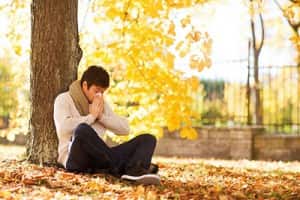HA-CHOO!!!
 Are you tired of the sneezing, itchy eyes and scratchy throat already? Once again it’s time for the seasons to change, which brings on yet another round of allergies. Many of us found some relief in the summer months, but since the temperatures are starting to drop a little, allergies will begin to flare up again. Although there are a few differences between Fall and Spring allergies, in the end they both can be a pain to have. Let’s focus on the differences, symptoms, and tips to help control them. Indianapolis Optometrist Dr. Amy Walden & Associates want to make sure that you can still enjoy the leaves and weather changes, and not suffer from allergy symptoms all season long.
Are you tired of the sneezing, itchy eyes and scratchy throat already? Once again it’s time for the seasons to change, which brings on yet another round of allergies. Many of us found some relief in the summer months, but since the temperatures are starting to drop a little, allergies will begin to flare up again. Although there are a few differences between Fall and Spring allergies, in the end they both can be a pain to have. Let’s focus on the differences, symptoms, and tips to help control them. Indianapolis Optometrist Dr. Amy Walden & Associates want to make sure that you can still enjoy the leaves and weather changes, and not suffer from allergy symptoms all season long.
The Difference Between Fall And Spring Allergies
As the trees start to bloom in the Spring, tree pollen is released. This is the biggest culprit of Spring allergies that people tend to suffer from. Grass and weeds are other common triggers. Mowing the lawn and pulling weeds while planting flowers or vegetables maybe some of the reasons why your allergies flare-up in the spring. On windy days, this stirs up the pollen and carries it through the air, but on rainy days, the pollen count drops, which makes it easier for people to “breathe”.
Now that we know the main trigger in the Spring is tree pollen, what is the main culprit in the Fall? If you thought weed pollen, this is correct. Ragweed is the most common culprit that seems to trigger people. As the colder mornings and nights become more common, the ragweed can travel through the air for hundreds of miles. So even if your particular area does not have ragweed growing, you may still experience some of the allergy symptoms. Did you know if you are allergic to ragweed, you may also be sensitive to bananas, melons, zucchini, and other fruits and vegetables? It is stated that about 3/4 of people who are allergic to tree pollen are also allergic to ragweed. Other allergens include pollen from trees and beans and mold spores in the dirt.
Common Fall & Spring Allergy Symptoms:
- Sneezing
- Stuffy Nose
- Nasal Congestion
- Runny Nose
- Itchy Eyes
- Pink Eyes
- Sore Throat
- Itchy ears
- Fatigue
Contact Indianapolis Optometrist Dr. Amy Walden & Associates or your eye doctor if your symptoms continue to worsen. Some of these symptoms can cause damage to your eyes if untreated. It’s better to be proactive and find remedies then to be miserable and suffer all season long.
Indianapolis Optometrist Tips To Prevent Allergy Attacks:
- Minimize your time outdoors during high ragweed counts
- Keep your windows closed during the day
- Keep yourself and children away from leaves (As pretty as they may be, they can carry mold.)
- Wash hands and clothes after being outside
- Purchase a dehumidifier or place a bowl of water under the vent
- Wear a mask when raking leaves or mowing
- Have your air ducts cleaned (This will avoid dust mites from entering your home). Clean carpets as the season’s change
- Wash all clothing that was packed away in a closet, attic or basement
-
-
Clean surfaces with a damp cloth rather than with a duster (this will prevent dust from flowing into the air and floating around). Although these are all great ways to avoid allergies, sometimes it is just impossible to avoid these pesty things.
Visit Dr. Amy Walden & Associates, your Indianapolis Optometrist to see what the best approach is to conquer your Fall allergies. As an Indianapolis Optometrist, I often recommend eye drops to keep the eyes moist. Sometimes a prescription or other alternatives to best suit your situation. Hopefully, the knowledge of your allergy symptoms and these tips are of help to the allergy sufferers out there so you can enjoy the beautiful Fall weather.
